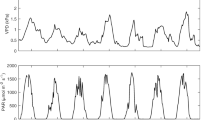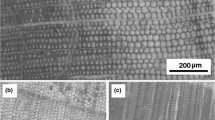Abstract
To estimate whole-tree water use when employing sap flow measurements, integration of the sap flux density (F d) over the sapwood area is needed. Accordingly, it is necessary to obtain information on the characteristics of stem water transportation such as spatial variations in F d and the active xylem area in the stem cross-section. Although evergreen oak trees with radial-porous wood represent a major component of secondary forests in western Japan, detailed information on their stem water transportation characteristics remains unclear. In the present study, we used the heat dissipation method (Granier method) to conduct measurements of azimuthal and radial variations in the F d of Quercus glauca Thunb. ex Murray, a representative evergreen broad-leaved tree in western Japan. Further, by analyzing the anatomy of the xylem structure, we examined why F d varies spatially in the stem cross-section. By using a dye solution injected into a radial hole bored into the tree trunk, we confirmed that the entire stem is hydroactive. We also compared the spatial variations in F d and water conductivity per xylem area (K s) which were estimated by using the observed vessel diameters and their density over the stem cross-section and Hagen–Poiseuille’s law. Azimuthal and radial variations in F d reached about 60 and 50% of the maximum values, respectively, and could be explained by spatial variation in K s. As a result, we obtained statistical parameters describing the spatial variation in F d in Q. glauca and determined that whole-tree water use estimated from measurements in one direction had at most ±20% potential errors for studied trees.







Similar content being viewed by others
References
Čermák J, Cienciala E, Kučera J, Hallgren JE (1992) Radial velocity profiles of water flow in trunks of Picea exelsa and oak and the response of spruce to severing. Tree Physiol 10:367–380
Delzon S, Sartore M, Granier A, Loustau D (2004) Radial profiles of sap flow with increasing tree size in maritime pine. Tree Physiol 24:1285–1293
Fernández JE, Durán PJ, Palomo MJ, Diaz-Espejo A, Chamorro V, Girón IF (2006) Calibration of sap flow estimated by the compensation heat pulse method in olive, plum and orange trees: relationships with xylem anatomy. Tree Physiol 26:719–728
Gartner BL (1995) Patterns of xylem variation within a tree and their hydraulic and mechanical consequences. In: Gartner BL (ed) Plant stems: physiology and functional morphology. Academic, San Diego, pp 125–149
Granier A (1987) Evaluation of transpiration in a Douglas-fir stand by means of sap flow measurements. Tree Physiol 3:309–320
Granier A, Anfodillo T, Sabatti M, Cochard H, Dreyer E, Tomasi M, Valentini R, Bréda N (1994) Axial and radial water flow in the trunks of oak trees: a quantitative and qualitative analysis. Tree Physiol 14:1383–1396
Hirose S, Kume A, Takeuchi S, Utsumi Y, Otsuki K, Ogawa S (2005) Stem water transport of Lithocarpus edulis, an evergreen oak with radial-porous wood. Tree Physiol 25:221–228
Hotta M (1974) History and geography of plants: evolutionary biology in plants, vol 3. Sanseido, Tokyo
Itoh T (1995) Anatomical description of Japanese hardwoods I. Wood Res Tech Notes 31:81–181
James SA, Clearwater MJ, Meinzer FC, Goldstein G (2002) Heat dissipation sensors of variable length for the measurement of sap flow in trees with deep sapwood. Tree Physiol 22:277–283
Kaimal JC, Finnigan JJ (1994) Atmospheric boundary layers flows: their structure and management. Oxford University Press, New York
Kira T, Yabuki K (1978) Primary production rates in the Minamata forest. In: Kira T, Ono Y, Hosokawa T (eds) Biological production in a warm-temperate evergreen oak forest of Japan. Tokyo University Press, Tokyo, pp 131–138
Kumagai T, Aoki S, Nagasawa H, Mabuchi T, Kubota K, Inoue S, Utsumi Y, Otsuki K (2005a) Effects of tree-to-tree and radial variations on sap flow estimates of transpiration in Japanese cedar. Agric For Meteorol 135:110–116
Kumagai T, Aoki S, Shimizu T, Otsuki K (2007) Sap flow estimates of stand transpiration at two slope positions in a Japanese cedar forest watershed. Tree Physiol 27:161–168
Kumagai T, Nagasawa H, Mabuchi T, Ohsaki S, Kubota K, Kogi K, Utsumi Y, Koga S, Otsuki K (2005b) Sources of error in estimating stand transpiration using allometric relationships between stem diameter and sapwood area for Cryptomeria japonica and Chamaecyparis obtusa. For Ecol Manage 206:191–195
Kumagai T, Saitoh TM, Sato Y, Morooka T, Manfroi OJ, Kuraji K, Suzuki M (2004) Transpiration, canopy conductance and the decoupling coefficient of a lowland mixed dipterocarp forest in Sarawak, Borneo: dry spell effects. J Hydrol 287:237–251
Lu P, Müller WJ, Chacko EK (2000) Spatial variations in xylem sap flux density in the trunk of orchard-grown, mature mango trees under changing soil water conditions. Tree Physiol 20:683–692
Lu P, Urban L, Zhao P (2004) Granier’s thermal dissipation probe (TDP) method for measuring sap flow in trees: theory and practice. Acta Bot Sin 46:631–646
Meinzer FC, James SA, Goldstein G, Woodruff D (2003) Whole-tree water transport scales with sapwood capacitance in tropical forest canopy trees. Plant Cell Environ 26:1147–1155
Nadezhdina N, Čermák J, Ceulemans R (2002) Radial patterns of sap flow in woody stems of dominant and understory species: scaling errors associated with positioning of sensors. Tree Physiol 22:907–918
Oren R, Phillips N, Ewers BE, Pataki DE, Megonigal JP (1999) Sap-flux-scaled transpiration responses to light, vapor pressure deficit, and leaf area reduction in a flooded Taxodium distichum forest. Tree Physiol 19:337–347
Phillips N, Oren R, Zimmermann R (1996) Radial patterns of xylem sap flow in non-, diffuse- and ring- porous tree species. Plant Cell Environ 19:983–990
Saeki H, Harada H (1985) Cells of hardwood. In: Saeki H, Harada H (eds) Structure of wood. Bun-ei-do, Tokyo, pp 49–100
Sano Y, Okamura Y, Utsumi Y (2005) Visualizing water-conduction pathways of living trees: selection of dyes and tissue preparation methods. Tree Physiol 25:269–275
Tyree MT, Zimmermann MH (2002) Xylem structure and the ascent of sap, 2nd edn. Springer, Berlin
Villar-Salvador P, Castro-Díez P, Pérez-Rontomé C, Montserrt-Martí G (1997) Stem xylem features in three Quercus (Fagaceae) species along a climatic gradient in NE Spain. Trees 12:90–96
Wheeler EA, Baas P, Gasson PE (1989) IAWA list of microscopic features for hardwood identification. IAWA Bull ns 10:219–332
Wilson KB, Hanson PJ, Mulholland PJ, Baldocchi DD, Wullschleger SD (2001) A comparison of methods for determining forest evapotranspiration and its components: sap-flow, soil water budget, eddy covariance and catchment water balance. Agric For Meteorol 106:153–168
Wullschleger SD, Hanson PJ, Todd DE (2001) Transpiration from a multi-species deciduous forest as estimated by xylem sap flow techniques. For Ecol Manage 143:205–213
Wullschleger SD, King AW (2000) Radial variation in sap velocity as a function of stem diameter and sapwood thickness in a yellow-poplar trees. Tree Physiol 20:511–518
Zang D, Beadle CL, White DA (1996) Variation of sapflow velocity in Eucalyptus globulus with position in sapwood and use of a correction coefficient. Tree Physiol 16:697–703
Acknowledgments
This work was supported by Grants-in-Aid for Scientific Research (nos. 17380096 and 17510011) from the Ministry of Education, Science and Culture, Japan. We thank A. Kume and K. Yoda for providing the opportunity to conduct this study. We are also grateful to M. Chiwa, I. Murata, Y. Shinohara, and T. Inoue for their able assistance in the field.
Author information
Authors and Affiliations
Corresponding author
Additional information
Communicated by E. Beck.
Rights and permissions
About this article
Cite this article
Tateishi, M., Kumagai, T., Utsumi, Y. et al. Spatial variations in xylem sap flux density in evergreen oak trees with radial-porous wood: comparisons with anatomical observations. Trees 22, 23–30 (2008). https://doi.org/10.1007/s00468-007-0165-8
Received:
Revised:
Accepted:
Published:
Issue Date:
DOI: https://doi.org/10.1007/s00468-007-0165-8




